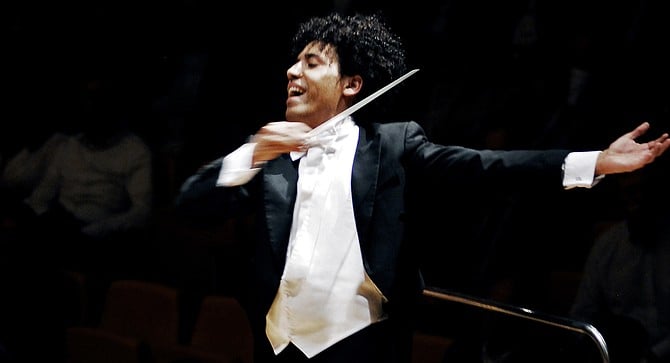 Facebook
Facebook
 X
X
 Instagram
Instagram
 TikTok
TikTok
 Youtube
Youtube

Rafael Payare made his debut as the San Diego Symphony music director on Thursday, January 10. I went on Friday, January 11, and experienced a completely different concert. Part of me wishes I had gone Thursday as well because the programing appealed to me more. Who cares if a concert appeals to me? Because every concert I go to is all about me. How could it be any other way?
The Thursday program included Tchaikovsky’s Variations on a Rococo Theme along with Ravel’s orchestration of Mussorgsky’s Pictures at an Exhibition. Based on the Friday performance of Richard Strauss’s Don Juan, the Pictures at an Exhibition must have been spectacular.
Speaking of Don Juan, the energy which infused the performance was beyond what I was expecting. I wasn’t expecting low energy with Payare stirring the stick but good Lord, was this an exciting performance. Exciting but still in need of being cleaned up. I’ve no doubt that will occur as Payare and the orchestra get to know one another.
Following Don Juan was Benjamin Britten’s Symphony for Cello and Orchestra. The piece was written in 1962 specifically for Mislav Rostropovich, arguably the greatest cellist in the world at the time.
The cellist on Friday night was Alisa Weilerstein. The Britten is considered one of the most difficult pieces in the repertoire. Britten composed it in such a way that the tone of the cellist is often obscured.
I still don’t know what Weilerstein’s playing sounds like. This is one of the reasons I wish I had been able to go on Thursday to hear her play the Rococo Variations.
Britten seemed to be taking us on a tour of the orchestra as different sections accompanied the cello. In some ways it was reminiscent of his famous Young Person’s Guide to the Orchestra.
The final piece was Shostakovich’s Symphony No. 10. I don’t wish to refer to Payare’s background as principal horn for The Simon Bolivar Orchestra often. In this case I think it significant because the “Shostie 10” was/is one of that orchestra’s calling cards and Payare proved he has lived and breathed, as a horn player, this symphony from the inside out and the outside in.
If this performance of Shostakovich is any indication of the future, and it is, then we are in for a quite a ride with Maestro Payare and his San Diegans.


Rafael Payare made his debut as the San Diego Symphony music director on Thursday, January 10. I went on Friday, January 11, and experienced a completely different concert. Part of me wishes I had gone Thursday as well because the programing appealed to me more. Who cares if a concert appeals to me? Because every concert I go to is all about me. How could it be any other way?
The Thursday program included Tchaikovsky’s Variations on a Rococo Theme along with Ravel’s orchestration of Mussorgsky’s Pictures at an Exhibition. Based on the Friday performance of Richard Strauss’s Don Juan, the Pictures at an Exhibition must have been spectacular.
Speaking of Don Juan, the energy which infused the performance was beyond what I was expecting. I wasn’t expecting low energy with Payare stirring the stick but good Lord, was this an exciting performance. Exciting but still in need of being cleaned up. I’ve no doubt that will occur as Payare and the orchestra get to know one another.
Following Don Juan was Benjamin Britten’s Symphony for Cello and Orchestra. The piece was written in 1962 specifically for Mislav Rostropovich, arguably the greatest cellist in the world at the time.
The cellist on Friday night was Alisa Weilerstein. The Britten is considered one of the most difficult pieces in the repertoire. Britten composed it in such a way that the tone of the cellist is often obscured.
I still don’t know what Weilerstein’s playing sounds like. This is one of the reasons I wish I had been able to go on Thursday to hear her play the Rococo Variations.
Britten seemed to be taking us on a tour of the orchestra as different sections accompanied the cello. In some ways it was reminiscent of his famous Young Person’s Guide to the Orchestra.
The final piece was Shostakovich’s Symphony No. 10. I don’t wish to refer to Payare’s background as principal horn for The Simon Bolivar Orchestra often. In this case I think it significant because the “Shostie 10” was/is one of that orchestra’s calling cards and Payare proved he has lived and breathed, as a horn player, this symphony from the inside out and the outside in.
If this performance of Shostakovich is any indication of the future, and it is, then we are in for a quite a ride with Maestro Payare and his San Diegans.
Comments